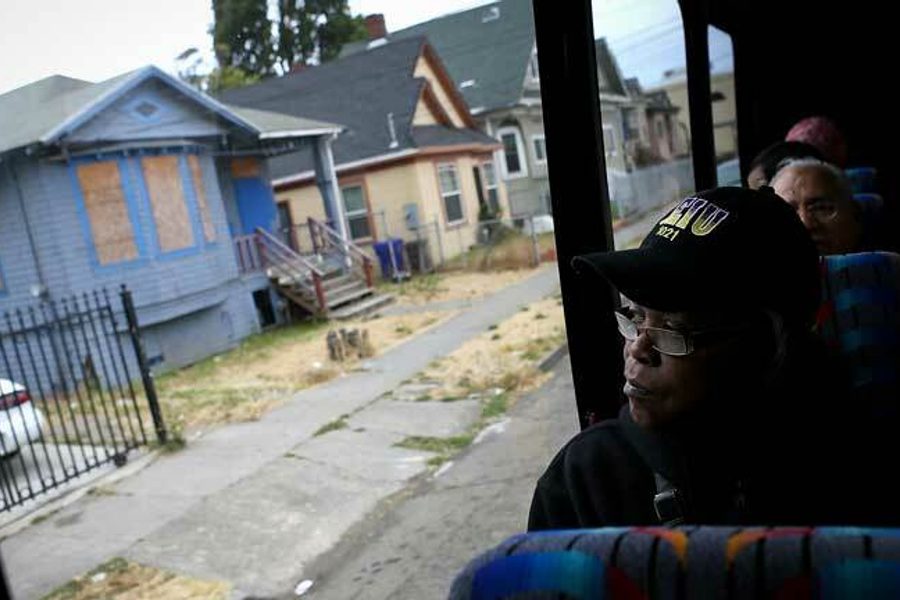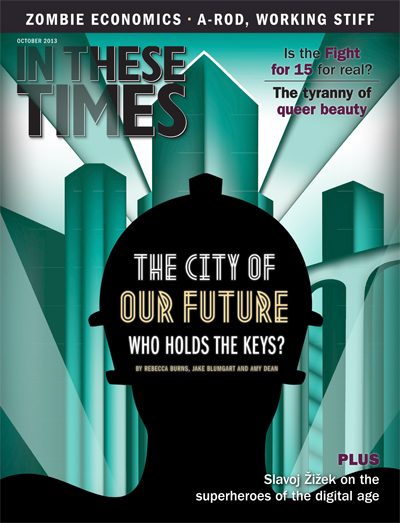A Company Town Becomes Our Town
How a town shadowed by Chevron built a vibrant movement to challenge corporate power.
Rebecca Burns

Richmond, Calif., is a company town in revolt. On August 3, more than 200 people were arrested at a sit-in at the gates of the Chevron oil refinery, the town’s largest employer, to mark the one-year anniversary of a disastrous refinery fire and protest the corporation’s ongoing role in climate change. The day before, city officials had announced that Richmond would sue Chevron for damages related to the fire, which landed more than 15,000 area residents in the hospital with injuries like smoke inhalation. Such a lawsuit would’ve been unthinkable 10 years ago, given Chevron’s stranglehold over local politics.
The city of 100,000 has grown up around the Chevron refinery, which is older than Richmond itself. Until 2005, the corporation was allowed to appoint its own inspectors, and last year’s fire was the third major accident to occur at the refinery since 1999. Seventy percent of Richmond’s residents are black, Latino or Asian American, and residents of North Richmond, where several public housing projects are located, bear the brunt of the health burden resulting from ongoing toxic exposure. Though it’s difficult to prove that high rates of asthma, cancer and heart disease among Richmond residents are linked to industrial pollutants — something community groups have long argued — people of color in Richmond have a life expectancy 10 years shorter than whites in other parts of the country, according to the city’s Health Equity Partnership.
Many who grew up in the shadow of the 3,000-acre refinery say they remember times when Chevron would send a few hundred dollars to their families after a spill occurred, paying hospital bills in exchange for families’ silence.
But over the past decade, Richmond’s residents have been building a vibrant movement to challenge corporate power. In 2006 voters ousted Mayor Irma Anderson, the pro-Chevron incumbent, and elected environmental activist Gayle McLaughlin. McLaughlin is fond of comparing the groundswell that brought her to office to anti-Chevron resistance movements in countries such as Nigeria and Ecuador, where the company maintains a heavy presence.
Indeed, Richmond bears the distinction of being the largest U.S. city to elect a Green Party mayor. The David vs. Goliath struggle has also brought together local labor, community and environmental groups in unprecedented ways, modeling new avenues for progressive urban politics.
Urban offense
Cities are often hailed as havens of high-minded progressivism, the engine of both economic recovery and positive social changes. In one prevailing narrative of urban revival — championed by urban theorist Richard Florida — urban idylls that attract members of the “creative class” provide the most fertile ground for experimentation in a post-industrial economy. Liberal social policies, in this view, also flourish best in the urban arena by simple fact of residents’ tolerant beliefs.
But cities have also served, during the past three decades, as the site of another type of experimentation: as laboratories of neoliberalism, where growth concentrated in urban centers has gone hand-in-hand with rising inequality. Against this backdrop, the celebrated liberalism of Richmond’s Bay Area neighbors Berkeley and San Francisco has increasingly given way to exclusion as real estate prices soar and the poor are pushed out amidst a green building boom.
Meanwhile, popular movements are on the defensive in traditional Left strongholds such as New York City and Chicago, where local leaders have attacked unions and privatized public services, signaling the triumph of a new breed of urban corporatism. A vision of the neoliberal city, replete with bike shares and LEED-certified buildings but empty of schools, jobs or housing for working people, is well on its way to becoming a reality (see “A Top-Down Revolution”).
Cities like Richmond — medium-sized, majority black and Latino, and beset by a host of social and economic ills — have been largely neglected by urban boosters of all stripes. But Richmond has nevertheless emerged as a pioneer of progressive reforms, providing a glimpse of what urban politics could look like when “innovation,” usually a mantra of neoliberal policy wonks, is driven by democratic movements.
The city has advanced a green agenda to rival those of its Bay Area neighbors — providing incentives to sustainable businesses and joining the campaign to divest city pension funds from the fossil fuel industry — but it’s coupled these initiatives with a solid commitment to social and economic reforms. While Portland and San Francisco have in recent years criminalized “acts of living,” Richmond has passed laws permitting homeless people to sit and sleep on sidewalks undisturbed. In August, the Richmond City Council passed the nation’s most comprehensive “ban the box” ordinance to date, which among other things improves ex-prisoners’ chances of reintegrating into society by prohibiting employers from asking about applicants’ criminal histories at any point during the hiring process. Richmond has also implemented innovative community policing agreements, issued municipal ID cards to aid undocumented residents and established a well-funded Office of Neighborhood Safety to address gun violence.
In part, necessity has been the mother of this kind of invention: Unemployment in Richmond stood at nearly 19 percent, as of 2011, with the poverty rate in North Richmond nearly double the state average of 14 percent.
“We’re not trying to take the mantle from Berkeley, or become known as a kooky town,” says Mike Parker, a local resident and Green Party activist. “It’s precisely because Richmond is working-class, and facing the same social problems as much of the rest of America, that we have to do things to challenge the status quo.”
Over the past decade, progressive activists in Richmond have built the power necessary to surmount these challenges, combining grassroots mobilization with electoral organizing to notch a string of victories in local races.
In 2003, local activists founded the Richmond Progressive Alliance (RPA), which began as a coalition of local Green Party activists and Latino community organizers who mobilized in the wake of police beatings at a 2002 Cinco de Mayo celebration. Since Richmond City Council elections are non-partisan, Green Party and Democratic Party activists could work together under the RPA umbrella, with the understanding that RPA candidates would not accept corporate donations, one of the key ways that Chevron controls local politics.
Since its founding a decade ago, the RPA has become an electoral force. Currently, one of the city’s six council members, as well as Mayor McLaughlin, are RPA members. In 2012, Chevron regrouped and with a war chest of $1.2 million helped defeat two new RPA-backed candidates. Since Richmond is governed by a council-city manager system, where the mayor has only one vote of seven, that leaves RPA activists with limited power in local government, for now.
Though the loss was a heavy one, RPA activists emphasize that the fight has never been solely about electoral politics. “We think of ourselves very much as an alliance, and we emphasize the importance of outside struggles,” says Parker. “But we’ve also tried to get to a place where we’re capable of getting the city to follow suit, if a movement leads.”
Community-labor alliance
Where theorists of urban revival have looked to itinerant “creatives” or visionary local leaders, the most important advances at the local level have come from community-labor alliances using new strategies to combat rising urban inequality.
The most recent initiative to land Richmond in the national spotlight — a plan to use the city’s power of eminent domain to seize and restructure underwater mortgages—raises the question of how many Goliaths a single city can take on at once. The plan, which involves condemning mortgages wrapped up in private label securities (PLS) in order to provide principal reductions to homeowners at higher risk of foreclosure, triggered a lawsuit against the city by government agencies Fannie Mae and Freddie Mac and investor groups representing holders of mortgage-backed securities. On September 16, proponents of the plan scored an important victory when a federal judge dismissed the lawsuit as premature, but the banks say they’ll bring another legal challenge. Meanwhile, lenders have effectively threatened to redline communities that adopt such plans.
The hang-ups with the foreclosure prevention plan also underscore the limitations of levying challenges to the status quo one city at a time. Use of eminent domain power to resolve the mortgage crisis is not a new idea: Numerous progressive commentators have advocated that the federal government adopt an approach akin to the Depression-Era Home Owners’ Loan Corporation to staunch the bleeding in the wake of the housing market crash. A version of this plan was introduced by Rep. Brad Miller (D-NC) in 2011, but failed to gain traction. In the absence of a broad enough movement to force a shift in federal policy, municipalities are left to try the measure on a more limited scale, also absorbing much of the risk.
While many of Richmond’s successes have stemmed from its ability to implement ideas generated by community coalitions, the eminent domain plan actually stems from a venture capital firm, Mortgage Resolution Partners (MRP), which has spent the past year and a half shopping a proposal to various municipalities whereby it would take a cut on each mortgage acquired through eminent domain in return for providing the necessary capital backing.
In Richmond, the city manager and council members were first approached by MRP, but community-based housing groups soon stepped in to investigate the proposal. Ultimately, the MRP president agreed to sign a statement of principles that includes the stipulation that no homeowner will be made worse off, says Amy Schur, campaign director for the Alliance of Californians for Community Empowerment (ACCE).
There are skeptics who point out, for starters, that since MRP’s business plan focuses primarily on buying mortgages where the homeowner is current on payments, and may not touch the second liens that often drive up the risk of foreclosure, it won’t actually do much to help those most in need. Moreover, since MRP’s role is limited to lining up the capital necessary to buy the loans and covering litigation fees that ensue, “a better plan wouldn’t need MRP,” says Yves Smith, the finance blogger behind Naked Capitalism and a prominent critic of the plan.
But others believe the plan could be the jumping off point for a broader foreclosure relief strategy, with the possibility of nonprofits or union pension funds pursuing the initiative in the future. “In an ideal world, you would not be reliant on a renegade Wall Street group to come up with the capital, but it’s what we’ve got for now,” says Demos Distinguished Senior Fellow Robert Kuttner.
Wages to live on
While the city is often elevated as the arena where community actors are most empowered to make change, the sources of many urban ills continue to lie beyond it. Faced with stagnating organizing gains at the industry level, many labor groups have thrown their weight behind local living-wage ordinances, which have passed in more than 100 cities. Community-labor alliances have also pioneered the “community benefits agreement” as a strategy for wringing concessions from developers. The coalitions at the heart of such victories often stumble, however, when faced with the question of how to take on existing industries, or when the goal of job creation conflicts with those of community and environmental health. Blue-green divisions that loom large during national debates on issues like the Keystone XL pipeline are often etched even deeper at the local level, precluding a broader economic justice movement.
In Richmond, the Asian Pacific Environmental Network (APEN), which organizes low-income Pacific islander communities in Richmond, and other environmental justice groups successfully sued in 2010 to block a proposed refinery expansion after showing that Chevron had not completed a full environmental-impact review. The move sparked a series of bitter confrontations between the local building trades unions — who would have gained 1,200 temporary jobs from the expansion, according to company estimates — and groups arguing that refining a heavier, dirtier form of crude oil could have calamitous consequences for the environment and public health.
The clashes between labor and environmental groups have shored up Chevron’s dominance. “The company has been very effective at pitting us against each other,” says Miya Yoshitani, APEN associate director. But the labor and environmental movements, which have both seen hard-won regulations rolled back during the past three decades, can find common ground when they target industries that disregard both worker and ecological health.
The Aug. 6, 2012, fire at the Richmond Chevron facility illuminated such shared interests, says Yoshitani. The blaze could have proved fatal for 19 workers enveloped in a vapor cloud released when a corroded pipe ruptured. An April 2013 investigation by the U.S. Chemical Safety Board concluded that Chevron had known about the corrosion for 10 years but had ignored a series of dire reports from its own technical personnel. Meanwhile, the warning system failed to work properly, leaving many residents unsure of what was happening as black smoke filled the city’s skies.
In the wake of the fire, local unions and environmental justice groups took unprecedented steps toward collaboration. A new Refinery Action Collaborative, consisting of APEN, the United Steelworkers (USW) International Union and USW Local 5, the University of California, Berkeley’s Labor and Occupational Health Program (LOHP), and several other local and national environmental groups, is demanding accountability from Chevron and an overhaul of state regulations for hazardous worksites.
Where blues and greens must still forge common ground is over the question of the refinery’s fate. Fighting for the refinery’s closure is a nonstarter for USW Local 5, which represents more than 600 workers at the facility. The collaborative quickly dispensed with this possibility at its initial meeting and agreed to focus on tightening safety regulations. The group is “still building trust and learning how to work together,” says Mike Smith, field representative for USW Local 5. “But [the union] has decided that when there are decisions being made about the health and safety of workers, or our jobs, we need to be at the table.”
Jobs vs. the environment
The group still has a way to go. The Steelworkers felt they were unable to participate in the August 3 march with 350.org, says Smith, because doing so could give the industry fodder to undermine the union’s relationship with its members. The collaborative has yet to weigh in on national questions like the Keystone pipeline, and is currently crafting its response to the possibility that heavier tar sands crude will soon be headed to Bay Area refineries. But Yoshitani thinks the group is now better able to address the issue than when tensions flared with labor in 2010 over the refinery expansion.
She also sees the collaborative as key to building a less fragmented Left able to address twin ecological and economic crises. In the 1970s, unions and environmentalists made common cause over the conditions of refinery workers in California, and a series of oil strikes soon blossomed into a nationwide movement. “Working towards a just transition is a process,” says Yoshitani. “But relationships between communities that have been most impacted by the fossil fuel industry are critical to its success.”
Rebecca Burns is In These Times’ housing editor and an award-winning investigative reporter. Her work has appeared in Business Insider, the Chicago Reader, the Intercept, ProPublica Illinois and other outlets.








